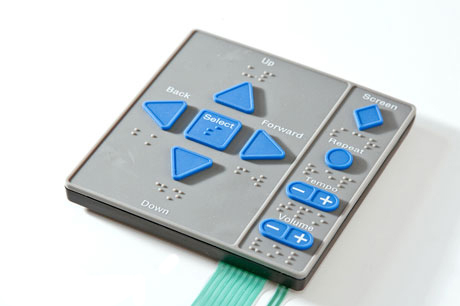Discover Just How Membrane Switches Feature and Their Role in Modern Electronics
Membrane Switches represent an advanced assimilation of innovation and layout within the world of contemporary electronics, offering as important interfaces in various tools. Comprised of numerous layers, these buttons use pressure-sensitive mechanisms to help with user communication. Their applications extend numerous sectors, from customer electronic devices to medical equipment, highlighting their adaptability and relevance. Understanding the intricacies of Membrane button functionality and their wider effects in boosting customer experience invites more exploration right into their design, benefits, and the ingenious developments forming their future in technology.
What Are Membrane Buttons?

Membrane switches are identified by their resilience and resistance to ecological aspects, such as dirt, dampness, and extreme temperature levels. They can be tailored with various graphics, shades, and responsive feedback options, improving customer experience while preserving aesthetic charm - membrane switches. The unification of published circuits allows for seamless assimilation right into devices, enhancing total capability.
The convenience of Membrane switches is noticeable in their capacity to support both complex and straightforward control functions. They can include attributes such as LED indicators and touch-sensitive innovation, satisfying specific user requirements. As innovation remains to evolve, Membrane Switches stay necessary for making it possible for efficient and user-friendly customer interfaces, consequently playing a critical duty in the advancement of contemporary electronic devices.
Elements of Membrane Switches
Membrane switches are composed of numerous vital parts that collaborate to develop a useful and trustworthy user interface. The main elements include the graphic overlay, sticky layer, spacer layer, and conductive traces.
The graphic overlay works as the interface, usually published on a flexible substratum such as polyester or polycarbonate. This layer not just supplies aesthetic allure yet additionally includes tactile responses, visual signs, and protective functions. Underneath the graphic overlay lies the sticky layer, which safeguards the switch to the tool and makes sure sturdiness against ecological stresses.
The spacer layer is important for keeping the needed space in between the visuals overlay and the circuit layer. When pressure is used, this gap enables for the activation of the switch. The conductive traces, usually made from silver or carbon, form the electric paths that complete the circuit when the switch is engaged.
Furthermore, a backing layer may be consisted of for structural support and insulation. These have a peek here components collaborate flawlessly, guaranteeing that Membrane switches are both user-friendly and resilient, making them indispensable in numerous contemporary electronic applications.
Exactly How Membrane Switches Job
Exactly how do Membrane Switches function effectively within digital devices? Membrane Switches run on the principles of pressure-sensitive modern technology, using a layered building that consists of visuals overlays, sticky layers, and conductive elements.
The design of Membrane switches is critical for their efficient operation (membrane switches). The layers are thoroughly engineered to provide responsive feedback, durability, and resistance to environmental elements such as wetness and dirt. The incorporation of domes-- little, elevated areas within the switch-- boosts responsive action, offering customers with a recognizable click experience upon activation
Furthermore, Membrane switches can be personalized in regards to dimension, form, and graphics, making them ideal for numerous applications. They are often used in control panels, clinical tools, and consumer electronics as a result of their sleek layout and reliability. Generally, the efficient functioning of Membrane switches is crucial in boosting customer interaction and ensuring smooth procedure in contemporary digital gadgets.

Applications in Modern Instruments
Using their unique layout and functionality, Membrane switches have actually become important components in a large range of modern electronic devices. These functional interfaces are employed in consumer electronic devices, commercial equipment, clinical tools, and auto controls, supplying seamless individual interaction.
In consumer electronics, Membrane buttons are frequently discovered in devices like microwaves, washing makers, and other home gadgets, where they enable intuitive control with a sleek profile. Their low-profile design promotes assimilation into portable tools, boosting visual allure without compromising capability.
In industrial applications, Membrane Switches offer as control panels for machinery, offering longevity and resistance to extreme atmospheres. Their ability to stand up to wetness and impurities makes them suitable for use in manufacturing and handling sectors.
Clinical devices also gain from Membrane buttons, which are designed to be simple to clean and keep, guaranteeing health in clinical setups. They are commonly used in diagnostic equipment, client tracking systems, and mobile medical devices, where dependability is extremely important.
Advantages of Membrane Buttons
Among the essential benefits of Membrane buttons is their convenience, which enables them to view it be tailored for a selection of applications across multiple industries. These switches can be made in numerous look at this web-site shapes and sizes, accommodating special product demands while giving smooth assimilation into devices. Their thin account makes it possible for a portable and sleek design, often enhancing the aesthetic allure of digital products.
One more substantial benefit is their sturdiness - membrane switches. Membrane buttons are commonly resistant to dust, wetness, and chemicals, making them suitable for extreme atmospheres. This durability extends their life expectancy contrasted to conventional mechanical switches, minimizing the need for constant replacements
Additionally, Membrane Switches offer cost-effectiveness. The manufacturing process includes printing innovations that minimize production prices, particularly for big runs. This cost, incorporated with reduced upkeep requirements, makes them an appealing option for suppliers.

Conclusion
In conclusion, Membrane Switches stand for a substantial advancement in individual interface technology within modern-day electronics. As the need for resistant and instinctive user interfaces proceeds to expand, the role of Membrane switches in shaping user experience will most certainly increase.
Membrane Switches stand for a sophisticated assimilation of modern technology and design within the world of modern-day electronic devices, offering as important interfaces in countless gadgets.In the world of modern electronic devices, Membrane Switches serve as crucial parts that help with customer communication with gadgets. As modern technology proceeds to evolve, Membrane Switches stay vital for allowing reliable and intuitive customer interfaces, thus playing a critical duty in the innovation of modern electronic gadgets.
Just how do Membrane Switches feature successfully within digital devices? Overall, the reliable performance of Membrane buttons is critical in boosting user interaction and ensuring smooth procedure in modern electronic gadgets.
 Andrea Barber Then & Now!
Andrea Barber Then & Now! Freddie Prinze Jr. Then & Now!
Freddie Prinze Jr. Then & Now! Monica Lewinsky Then & Now!
Monica Lewinsky Then & Now! Heather Locklear Then & Now!
Heather Locklear Then & Now! Bernadette Peters Then & Now!
Bernadette Peters Then & Now!